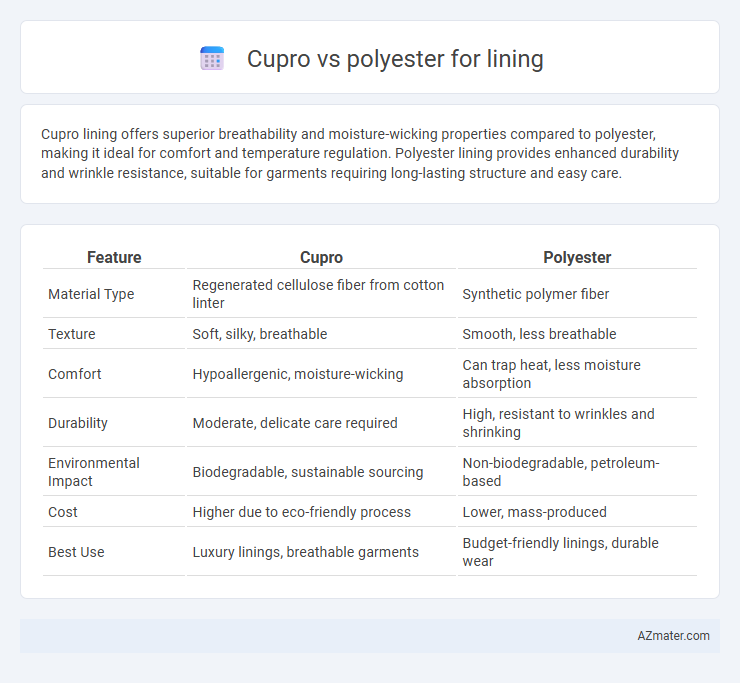Cupro lining offers superior breathability and moisture-wicking properties compared to polyester, making it ideal for comfort and temperature regulation. Polyester lining provides enhanced durability and wrinkle resistance, suitable for garments requiring long-lasting structure and easy care.
Table of Comparison
| Feature | Cupro | Polyester |
|---|---|---|
| Material Type | Regenerated cellulose fiber from cotton linter | Synthetic polymer fiber |
| Texture | Soft, silky, breathable | Smooth, less breathable |
| Comfort | Hypoallergenic, moisture-wicking | Can trap heat, less moisture absorption |
| Durability | Moderate, delicate care required | High, resistant to wrinkles and shrinking |
| Environmental Impact | Biodegradable, sustainable sourcing | Non-biodegradable, petroleum-based |
| Cost | Higher due to eco-friendly process | Lower, mass-produced |
| Best Use | Luxury linings, breathable garments | Budget-friendly linings, durable wear |
Introduction to Cupro and Polyester Linings
Cupro linings, made from regenerated cellulose fibers derived from cotton linter, offer a silky texture, breathability, and eco-friendly attributes, making them a popular choice for luxury garments. Polyester linings, created from synthetic polymers, provide durability, wrinkle resistance, and cost-effectiveness, commonly found in mass-market clothing. Selecting between cupro and polyester linings depends on factors such as comfort, sustainability, and garment care requirements.
What Is Cupro? Key Properties and Composition
Cupro is a regenerated cellulose fiber made from cotton linter, known for its silky texture and excellent breathability, making it a premium choice for fabric linings. Its key properties include moisture-wicking capabilities, natural anti-static behavior, and a smooth, lustrous finish that enhances garment comfort and durability. Unlike polyester, which is a synthetic fiber derived from petroleum, cupro is biodegradable and offers superior moisture absorption, reducing discomfort from sweat and heat during wear.
Polyester Lining: Features and Benefits
Polyester lining offers high durability and excellent resistance to wrinkles, making it an ideal choice for long-lasting garments. Its moisture-wicking properties enhance comfort by keeping the wearer dry and cool in various conditions. Polyester is also cost-effective and easy to maintain, providing superior wrinkle resistance compared to cupro, which often requires more delicate care.
Sustainability: Cupro vs Polyester Environmental Impact
Cupro, a regenerated cellulose fiber made from cotton waste, offers a biodegradable and biodegradable alternative to traditional polyester linings, which are derived from petroleum and contribute to microplastic pollution. The production of Cupro involves less energy and fewer harmful chemicals compared to polyester manufacturing, resulting in a lower carbon footprint. Polyester linings, while durable and cost-effective, pose significant environmental challenges due to their non-biodegradable nature and reliance on fossil fuels.
Breathability and Comfort Comparison
Cupro lining offers superior breathability compared to polyester due to its natural cellulose fibers, which allow better moisture absorption and air circulation. Polyester, made from synthetic polymers, tends to trap heat and moisture, often leading to discomfort and reduced ventilation in garments. The enhanced breathability of cupro contributes to higher comfort levels, especially in warm climates or extended wear.
Durability and Longevity: Which Lasts Longer?
Cupro lining offers superior breathability and moisture absorption compared to polyester, making it less prone to degradation over time. Polyester linings, while more resistant to abrasion and staining, tend to wear out faster due to their lower breathability and tendency to retain heat and moisture. Overall, cupro linings generally last longer and maintain fabric integrity better than polyester in terms of durability and longevity.
Care and Maintenance: Ease of Cleaning
Cupro linings are prized for their natural breathability and easy cleaning, as they can typically be hand washed or dry cleaned without compromising the fabric's integrity. Polyester linings offer high durability and stain resistance, allowing for machine washing and quicker drying times, making maintenance less demanding. Both fabrics require careful attention to care labels, but cupro's delicate nature often demands gentler handling compared to the robust, low-maintenance polyester.
Cost Differences Between Cupro and Polyester
Cupro linings typically cost significantly more than polyester due to the complex production process involving regenerated cellulose fibers derived from cotton waste. Polyester, a synthetic fiber made from petroleum, is cheaper to manufacture and widely available, resulting in lower prices for garments lined with it. This cost difference influences fashion designers and manufacturers when balancing quality and budget for clothing interiors.
Best Uses: Ideal Garments for Each Lining
Cupro linings excel in luxury garments like blazers, suits, and eveningwear due to their breathability, smooth texture, and natural moisture-wicking properties, enhancing comfort and drape. Polyester linings are best suited for everyday wear such as jackets, skirts, and dresses where durability, ease of care, and affordability are priorities, offering wrinkle resistance and color retention. Designers select cupro for premium, breathable finishes in high-end fashion while polyester is favored for versatile, budget-friendly options in mass-produced clothing.
Conclusion: Choosing the Right Lining Fabric
Cupro offers superior breathability, moisture-wicking properties, and a luxurious silk-like texture, making it ideal for high-end, comfortable garment linings. Polyester provides durability, wrinkle resistance, and cost-effectiveness, suitable for budget-friendly and easy-care garments. Selecting the right lining fabric depends on balancing comfort and performance needs with budget constraints and garment type.

Infographic: Cupro vs Polyester for Lining
 azmater.com
azmater.com